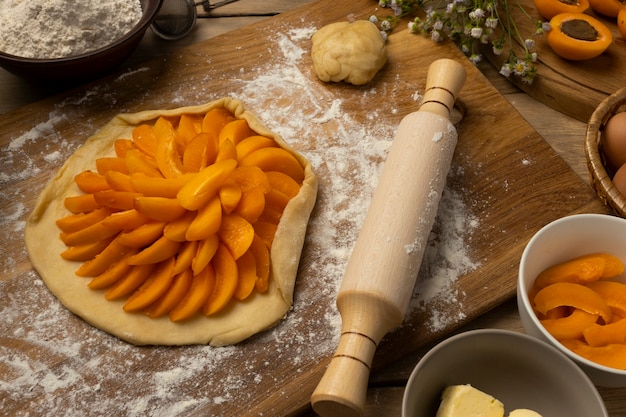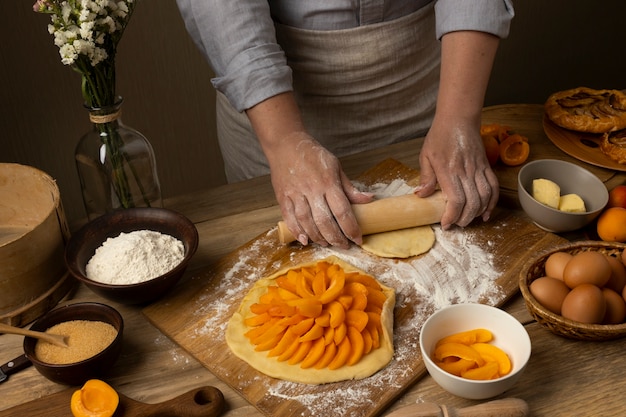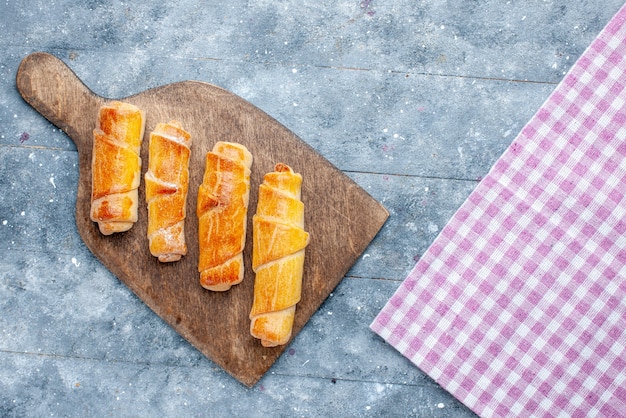I'm here to tell you, there's something truly magical about a perfectly baked sweet potato. It's more than just a side dish; it's a sweet, comforting experience that warms you from the inside out. And I'm not just saying that because I'm a bit obsessed with them. I've seen the look on people's faces when they bite into a perfectly cooked sweet potato, and it's pure joy. It's that combination of melt-in-your-mouth sweetness and a satisfyingly crispy exterior that makes it irresistible. So, today, I want to share my tried-and-true secrets for baking the absolute best sweet potatoes, the kind that will leave you craving more.
(Part 1) Choosing Your Sweet Potato

The journey begins with selecting the perfect sweet potato. Think of it like choosing the right ingredients for a cake – you want to start with the best possible foundation for a truly delicious result.
Choosing the Right Variety
Sweet potatoes come in a dazzling array of varieties, each with its own unique personality, flavor, and color. But for baking, I'm a firm believer in sticking with the classic orange-fleshed sweet potato. They have a rich, warm color that instantly evokes sunshine and summer days, and their flavor is simply unbeatable.
- Beauregard: These are my go-to sweet potatoes for baking. They have a deep orange flesh that boasts a wonderfully rich, sweet flavor. It's like a hug in a sweet potato, I tell you.
- Jewel: Jewel sweet potatoes have a striking purple skin and a lighter orange flesh. Their flavor is slightly less sweet than Beauregards, but they still offer a delightful sweetness that's perfect for baking.
- Covington: If you're looking for a sweet potato with a unique twist, Covington is the way to go. They have red skin and yellow flesh, and a flavor that's a bit more earthy and complex. It's a little bit different, but in the best way possible.
Picking the Perfect Spud
Once you've chosen your variety, it's time to find the perfect sweet potato. Here's what I look for when I'm browsing the produce aisle:
- Firm and Smooth: I want a sweet potato that feels solid and firm, not soft or mushy. It should be free of any wrinkles or soft spots.
- No Green Shoots: Those green shoots are a sign that the sweet potato has started to sprout, and they can give it a bitter taste. So, stay away from any spuds with those pesky green shoots.
- No Cracks or Cuts: You want a sweet potato that's in pristine condition, without any cracks, cuts, or bruises. This ensures that it bakes evenly and beautifully.
Don't be afraid to give the sweet potatoes a little squeeze to test their firmness. You're looking for a sweet potato that feels heavy for its size, which means it's packed with deliciousness.
(Part 2) Preparing Your Sweet Potato

You've got your perfect sweet potato, now it's time to get it ready for its grand entrance into the oven. Think of this as prepping your race car – a little bit of work now will lead to a fantastic result later.
Washing and Scrubbing
First things first, give your sweet potato a good scrub. You want to remove any dirt, debris, or lingering traces of soil that might be clinging to it. I usually use a vegetable brush for a thorough cleaning, but a good rinse under the tap works just as well. Just make sure those little guys are sparkling clean!
Cutting and Slicing
Now, the fun part: deciding how to cut your sweet potato. There are a few options, each with its own advantages and resulting texture.
- Whole: This is the simplest way to bake a sweet potato. It's perfect if you want a rustic, old-fashioned look and a soft, melty texture. It's a little bit more hands-off and allows the sweet potato's natural flavors to really shine.
- Halved: Cutting your sweet potato in half makes it easier to bake and can also help to enhance its sweetness. This is a good option if you want to speed up the cooking time a little bit.
- Sliced: Sliced sweet potatoes are ideal for roasting. They cook faster than whole or halved potatoes and offer a beautiful, crispy texture. It's also a great way to get more surface area for flavorful toppings.
Ultimately, the way you cut your sweet potato is a matter of personal preference. Experiment with different methods to see what you enjoy the most.
Pricking and Drizzling
Now, here's a crucial step: pricking those sweet potatoes! This little trick lets steam escape during baking, preventing them from exploding in the oven. It's a little safety measure that ensures a smooth and enjoyable baking experience. You can use a fork, a skewer, or even a sharp knife to prick the sweet potato. Just make sure you create a few holes for the steam to escape.
While you're at it, give your sweet potatoes a generous drizzle of olive oil. This adds a touch of flavor and helps them to develop a beautiful, crispy exterior while they bake. I like to use extra virgin olive oil for its robust flavor and health benefits.
(Part 3) Baking Your Sweet Potato

Finally, it's time to put those sweet potatoes in the oven and let the magic happen. This is the moment we've all been waiting for!
Oven Temperature and Baking Time
The ideal oven temperature for baking sweet potatoes is between 350-400°F (175-200°C). This allows them to bake evenly and develop a beautiful golden-brown color.
Now, the baking time will vary depending on how you've cut your sweet potatoes. Here's a general guide:
| Cut | Baking Time |
|---|---|
| Whole | 45-60 minutes |
| Halved | 30-40 minutes |
| Sliced | 20-30 minutes |
The key is to bake them until they're tender enough to easily pierce with a fork. You'll know they're ready when the flesh is soft and the edges are lightly caramelized.
Tips for Baking Sweet Potatoes
Here are a few more tips to help you bake the most perfect sweet potatoes:
- Baking Sheet or Pan: Use a baking sheet or pan lined with parchment paper to prevent sticking. This makes for easy clean-up and ensures your sweet potatoes bake evenly.
- Space Them Out: Don't crowd your sweet potatoes! Give them enough space to bake evenly on all sides. This is essential for achieving a beautifully crispy exterior.
- Flip Them Over: Flip your sweet potatoes halfway through baking for a more even cook. This ensures that both sides get a chance to brown and become deliciously crispy.
(Part 4) sweet potato toppings and Variations
The fun doesn't stop once your sweet potato is baked. Now it's time to get creative with toppings and flavor combinations. Think of them as the finishing touches that transform a simple baked sweet potato into a culinary masterpiece.
Classic Toppings
Here are a few classic toppings that never fail to deliver a delicious sweet potato experience:
- Butter and Salt: This is the epitome of simplicity, and sometimes simple is best. Just melt some butter over the hot sweet potato and sprinkle with a touch of salt. It's pure comfort food magic.
- Maple Syrup: Sweet and sticky maple syrup is a match made in heaven with sweet potato. It's a delightful blend of sweetness that's both comforting and indulgent.
- Cinnamon and Nutmeg: Warm spices like cinnamon and nutmeg add a touch of holiday cheer to your sweet potato. They create a warm and comforting flavor that's perfect for colder months.
Savoury Sweet Potato Delights
Don't be afraid to venture beyond the sweet and explore some savory flavor combinations with your sweet potato. You might be surprised at how delicious they can be!
- Chili and Lime: This zesty combination of chili flakes and lime juice adds a touch of heat and brightness to your sweet potato. It's a perfect blend of sweet, spicy, and tangy.
- Bacon and Cheese: crispy bacon and sharp cheddar cheese elevate your sweet potato to a whole new level of indulgence. It's a savory and satisfying combination that's perfect for a hearty meal.
- Avocado and Salsa: This healthy and refreshing option is perfect for a lighter meal or as a side dish. The creamy avocado and zesty salsa create a delicious contrast in texture and flavor.
(Part 5) Storing and Reheating
You've just baked the perfect sweet potato, but what happens when you can't eat it all at once? Don't worry, storing and reheating your sweet potato is a breeze.
Storing Your Sweet Potato
If you have any leftover baked sweet potato, simply store it in an airtight container in the fridge for up to 3 days. This will keep it fresh and flavorful.
Reheating Your Sweet Potato
To reheat your sweet potato, you have a few options:
- Oven: Preheat your oven to 350°F (175°C) and bake for 10-15 minutes, or until heated through. This is a great option if you want to ensure that your sweet potato is crispy and warm throughout.
- Microwave: Microwave your sweet potato on high for 30-60 seconds, or until heated through. This is a quick and easy way to reheat your sweet potato, but it might not be as crispy as baking it.
- Toaster Oven: Reheat your sweet potato in a toaster oven for 5-10 minutes, or until heated through. This is a good option for a crispier texture than the microwave, but not quite as crispy as baking it in the oven.
No matter how you choose to reheat your sweet potato, make sure it's piping hot before you enjoy it!
(Part 6) Sweet Potato: More than Just a Side Dish
Sweet potatoes are so versatile, you can use them in so many different dishes, both sweet and savory. They're a true culinary chameleon, and they can be the star of the show or a supporting player, always delivering a delicious punch of flavor.
sweet potato smoothies
Start your day with a boost of sweetness and nutrients with a sweet potato smoothie. The natural sweetness and creamy texture of sweet potato blend beautifully with your favorite fruits and vegetables. It's a healthy and delicious way to get your daily dose of vitamins and fiber.
sweet potato pancakes
Next up, let's talk about fluffy, delicious pancakes. Adding sweet potato to your pancake batter adds a beautiful orange hue and a subtle sweetness that makes them extra special. It's a healthy and flavorful twist on a classic breakfast favorite.
Sweet potato bread
Looking for a moist and flavorful bread? sweet potato bread is a classic for a reason. The sweet potato adds a natural sweetness and a wonderful texture to the bread. It's perfect for a cozy afternoon snack or as a side for a savory meal.
Sweet potato soup
There's nothing quite like a bowl of warm and comforting sweet potato soup on a chilly day. It's creamy, delicious, and incredibly healthy. You can make it simple or get creative with different spices and toppings.
sweet potato curry
Let's take things up a notch with a delicious sweet potato curry. It's the perfect blend of sweet and savory flavors, with a touch of spice. It's a satisfying and flavorful dish that's perfect for a weeknight dinner or a special occasion.
(Part 7) The Sweet Potato as a Superfood
Sweet potatoes are more than just delicious; they're packed with nutrients that are good for your body and mind. They're a true superfood that deserves a place in your diet.
Packed with Vitamins and Minerals
Sweet potatoes are a powerhouse of vitamins and minerals. They're loaded with vitamin A, which is essential for healthy vision, skin, and immune function. They're also a good source of vitamin C, vitamin B6, potassium, and fiber.
Benefits for Your Body
So, what does this mean for your body? Well, sweet potatoes can help you:
- Boost your immune system: With all those vitamins and antioxidants, it's a natural shield against those pesky illnesses.
- Improve your digestion: The fiber in sweet potatoes keeps your digestive system happy and running smoothly.
- Control your blood sugar: The complex carbohydrates in sweet potatoes help to regulate your blood sugar levels.
Sweet Potatoes for Every Lifestyle
Whether you're a fitness fanatic, a health nut, or simply someone who loves delicious food, sweet potatoes have something for you. They're versatile, affordable, and packed with nutrients – what more could you ask for?
(Part 8) FAQs
You've got questions, I've got answers! Here are a few frequently asked questions about baking sweet potatoes:
- What if my sweet potato is too hard to bake? If your sweet potato is too hard, you can try soaking it in water for 30 minutes before baking. This will help to soften it up.
- Can I use a microwave to bake my sweet potato? You can, but it won't be as crispy as a baked sweet potato. It will be cooked through, but the texture will be a bit softer.
- What can I do with leftover sweet potato? You can use leftover sweet potato in soups, stews, salads, and even desserts. It's a great way to add flavor and texture to any dish.
- How long can I keep baked sweet potatoes in the fridge? Baked sweet potatoes can be stored in the fridge for up to 3 days.
- What if my sweet potato is too sweet? If your sweet potato is too sweet, you can try adding a pinch of salt to balance out the sweetness.
And that, my friends, is my ultimate guide to baking sweet potatoes. It's a journey of flavor, texture, and pure, unadulterated deliciousness. So, grab those sweet potatoes, get baking, and let the sweet potato magic begin!
Everyone is watching

Corn on the Cob: The Ultimate Guide to Perfectly Cooked Ears
Healthy MealsAh, corn on the cob. Just the name evokes images of sunny days, barbecues, and that sweet, juicy flavour that ...

Perfect Pork Roast Oven Cooking Time: A Guide to Delicious Results
Healthy MealsThere's something truly satisfying about a perfectly roasted pork. The aroma alone is enough to make your mout...

Scallops: The Ultimate Guide to Perfect Cooking
Healthy MealsAh, scallops. Those delicate, sweet, and utterly delicious morsels of the sea. They hold a special place in my...

Spaghetti Squash: The Ultimate Guide to Cooking and Serving
Healthy MealsRemember that time you saw spaghetti squash at the supermarket, looking all bumpy and strange, and thought, "W...

Ham Cooking Time: How Long to Bake, Smoke, or Boil a Delicious Ham
Healthy MealsAh, ham. It's a classic, isn't it? A real crowd-pleaser, especially around holidays. And when done right, it'...
